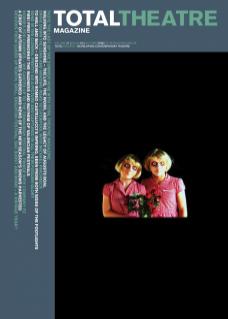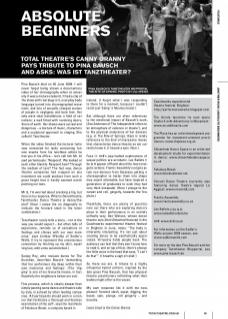Pina Bausch died on 30 June 2009. I will never forget being shown a documentary video of her choreography when at university (I was a mature student). It had a clip of the show with real dogs in it, everyday body language turned into choreographed movement, and lots of sexually charged scenes of people in negligees and bare feet. Her sets were total installations: a field of carnations; a wall fitted with revolving doors; floors of earth. Her shows were surreal and dangerous – a mixture of music, characters and a sculptural approach to staging. She called it Tanztheater.
When the video finished the lecturer (who was renowned for lazily consuming fun-size snacks from his lunchbox whilst he met you in his office – let’s call him Mr. B) said portentously: ‘Respond’. We looked at each other blankly: Respond how? Through the medium of tanz? The fact was, dance theatre companies had crapped on any movement we could produce from such a great height that it hardly seemed worth pointing our toes.
Mr B, I’m worried about cracking a hip, but here is my response. What is Dance-theatre, Tanztheater, Dance Theatre or dance/theatre? (Here I swipe the air diagonally to indicate the forward slash in the latter combination.)
‘Tanztheater rarely tells a story – not in the way you would expect – but often tells of experience, reminds us of sensations or feelings and chimes with our own memories,’ says Lindsay Winship of Sadler’s Wells. (I try to represent this unconscious connection by hitching up my skirt, squatting low, with arms outstretched.)
Sanjoy Roy, who reviews dance for The Guardian, describes Bausch ‘demanding that her performers dig deep within their own memories and feelings’. (The ‘digging’ is one of my favourite moves, in fact. Hopefully the neighbours below are out).
This process, which is clearly deeper than simply pasting some dance and theatre side by side, is echoed by other leading companies. ‘All participants should work in a manner that facilitates a thorough and fearless examination of the self’, says the manifesto of Fabulous Beast, a company based in Ireland. (I forgot what I was responding to there for a moment, because I couldn’t resist just ‘being’ a fabulous beast.)
But although there are often references to the emotional impact of Bausch’s work, (Zoe Anderson of The Independent refers to ‘an atmosphere of violence or shame’), and to the physical endurance of her dancers (e.g. in The Rite of Spring), there is rarely reference to the kind of impressive moves that characterise dance theatre as we currently know it. (I hazard a spin. Nice.)
Face it: DV8’s pop-fuelled explorations of sexual politics are acrobatic. Les Ballets C de la B appear offhand about the most energetic actions. Frantic Assembly’s origins as two non-dancers from Swansea getting a choreographer to batter them into shape may sound attainable, but have inspired a generation of graduates to wish they had very thick kneepads. (Here I plunge to the carpet and roll, gingerly, towards the fireplace.)
Thankfully, there are plenty of practitioners out there who are exploring dance’s place in their performance in an entirely unflashy way. Dan Watson, whose dance theatre solo Semi Detached featured in the Coachwerks experimental theatre festival in Brighton in June, notes: ‘The body is inherently interesting. It’s not just about creating dance to be aesthetically appreciated. Virtuosity holds people back. The audience can feel that they don’t know how to read it, and on top of that, there’s always the little voice in the head that says, “I can’t do that”’. (I breathe a sigh of relief.)
So there we are. A tribute to a highly influential hybrid artform, inspired by the late great Pina Bausch, that has physical theatre practitioners rethinking what their bodies might offer to the cause.
My own response (do it with me now, please): forward slash, squat, digging, the beast, spin, plunge, roll gingerly – and breathe.
Coachwerks experimental theatre festival, Brighton: http://performancewerks.blogspot.com
The Arcola launches its new space Studio K with Adventures in Movement: www.arcolatheatre.com
The Place has an artist development programme for movement-oriented practitioners: www.theplace.org.uk
Chisenhale Dance Space is an artist-led development studio for experimentation in dance: www.chisenhaledancespace. co.uk
Fabulous Beast: www.fabulousbeast.net
Vincent Dance Theatre (currently also featuring dance theatre legend Liz Aggiss): www.vincentdt.com
Frantic Assembly: www.franticassembly.co.uk
Les Ballets C de la B: www.lesballetscdela.be
DV8: www.dv8.co.uk
For information on the Sadler’s Wells autumn 2009 season, see www.sadlerswells.com
For more on the late Pina Bausch and her company Tanztheater Wuppertal, see www.pina-bausch.de

